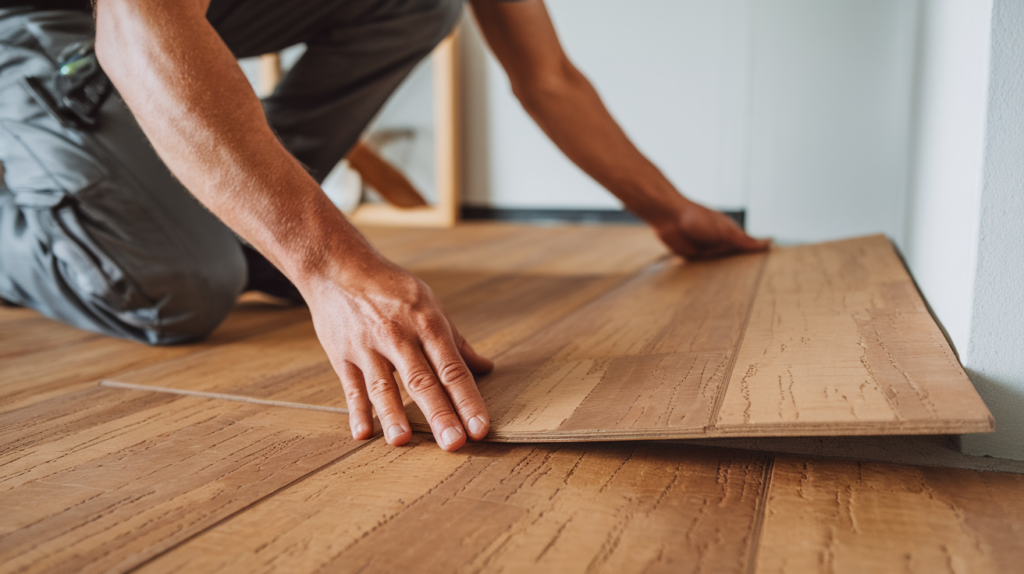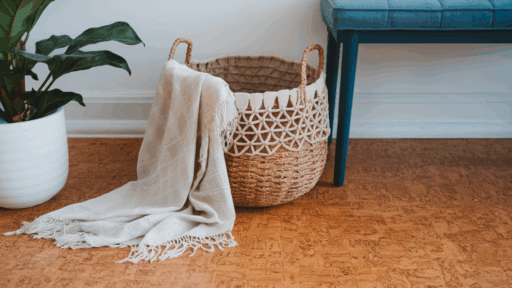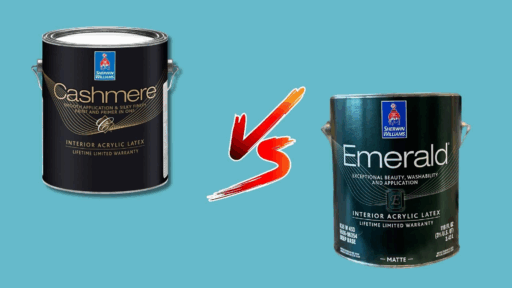Cork flooring is making a quiet comeback, and for good reason. When I began renovating my house, I wanted floors that were soft underfoot, helped with sound, and made from eco-friendly materials.
Cork checks all those boxes. It’s made from the bark of cork oak trees, and it grows back, so it’s a renewable option.
But like any flooring, cork has its perks and its quirks. It’s cozy and warm, but it can dent easily. It’s great for some rooms, not so great for others.
In this post, I’ll walk you through:
- What is cork flooring?
- How does it compare to other floors
- Simple care tips
If you’re thinking about cork for your home, this guide lays out the key details to help you make a smart choice.
You’ll get a clear look at what works, what doesn’t, and what to expect in between.
What Is Cork Flooring?
Cork flooring is made from the bark of cork oak trees, which are grown mainly in regions like Portugal and Spain.
The process starts with carefully stripping the bark from the tree, which doesn’t harm the tree itself.
After that, the cork is ground up and mixed with a binding agent, then formed into tiles, planks, or sheets.
One of the best things about cork is that it’s a naturally renewable material.
The cork oak tree can regrow its bark every 9 to 12 years, making it a sustainable choice. Cork floors are known for being soft underfoot.
They have a bit of bounce, which makes walking on them more comfortable. Because of this, cork is often used in places where you spend a lot of time on your feet, like kitchens or living rooms.
It’s also great in spaces where you want some extra sound insulation, such as in apartments or home offices.
The Pros of Cork Flooring

Cork flooring offers a unique blend of comfort, sustainability, and practicality. It’s becoming a popular choice for homeowners looking for an eco-friendly and cozy flooring option.
1. Soft and Cushiony Feel
Cork flooring has a soft and cushiony feel that makes it gentle on your joints.
If you’ve ever walked on tile or hardwood floors for a long time, you know they can be hard and uncomfortable. Cork is different.
Its structure provides a bit of bounce, which means it’s more forgiving to walk on, especially for people with joint pain or those who stand a lot.
It’s also a great choice if you like to walk barefoot at home because the surface is naturally warm and cozy.
2. Great Insulation
One of cork’s standout benefits is its insulating properties. Cork naturally traps air in its structure, making it a great choice for keeping your floors warm in the colder months.
It helps maintain a comfortable indoor temperature by acting as a thermal insulator. Additionally, cork’s insulation benefits extend to soundproofing.
This makes cork a good option for apartments or homes where noise reduction is important.
3. Eco-Friendly
Cork flooring is considered one of the most eco-friendly flooring options out there. It’s made from the bark of cork oak trees, which naturally regenerate after harvesting.
This means the tree isn’t harmed, and the bark can be collected every 9–12 years.
Additionally, cork production produces less waste than other flooring materials, making it a great choice for anyone wanting to reduce their carbon footprint.
4. Hypoallergenic Qualities
If allergies are an issue in your home, cork flooring could be a game-changer.
Unlike carpet, which can trap dust and allergens, cork resists mold, mildew, and dust naturally. This is thanks to its structure and the fact that cork doesn’t absorb moisture easily.
The material itself is also non-toxic, so you don’t have to worry about harmful chemicals being released into your home.
Cork is a great choice if you’re sensitive to allergens or want a cleaner environment.
5. Pet- and Kid-Friendly
Cork flooring is an ideal surface for pets and kids.
Its soft and slightly cushioned texture helps absorb the impact of falls, which reduces the chance of injury, especially for toddlers or young children learning to walk.
It also makes a great surface for pets who like to run around or nap on the floor. Cork is naturally durable, and it won’t easily show scratches or scuffs, making it pet-friendly.
6. DIY-Friendly Options
Cork flooring can be a DIY-friendly flooring option. If you enjoy tackling home improvement projects, cork might be a great fit.
The installation process is typically straightforward, and you won’t need to use glue or nails; just snap the pieces together, and you’re good to go.
If you’ve done basic DIY projects before, cork is a manageable and rewarding choice.
Even if you’re a beginner, you’ll find the process relatively easy compared to other flooring types like tile or hardwood.
The Cons of Cork Flooring

Understanding these potential drawbacks will help you make a more informed decision about whether cork is the right choice for your home. These are a few things to consider before choosing cork flooring for your space:
1. Easily Dented or Scratched
While cork flooring is comfortable and durable, it can be easily dented or scratched. Heavy furniture, sharp objects, and even high heels can leave marks on the surface.
If you have heavy furniture or kids running around with toys, you’ll need to be careful.
Using furniture pads and rugs can help protect your floors, but it’s still something to keep in mind when deciding if cork is right for your home.
2. Moisture Concerns
Cork is naturally absorbent, which means it can soak up water and lead to mold or mildew growth if exposed to moisture for too long.
This is a concern if you live in a humid area or need flooring in places like laundry rooms or bathrooms.
While cork can be sealed to prevent moisture damage, it’s something you’ll need to be mindful of when choosing where to install it.
3. Sunlight Sensitivity
Cork flooring is sensitive to direct sunlight and can fade or discolor over time.
If your cork floors are exposed to a lot of sun, the color may start to change, and the once-rich tone could dull. This fading is especially noticeable in lighter-colored cork floors.
If your home gets a lot of natural light, you might need to take extra steps to protect your cork floors, such as using rugs or window treatments to block some of the sun’s rays.
4. Needs Regular Sealing
To maintain its durability and resist moisture, cork flooring needs to be regularly sealed.
This is something to consider, as you’ll need to reseal the floors every few years to keep them looking good and functioning well.
Regular sealing can be a bit of work, but it’s necessary to protect your investment and keep your floors in good shape for the long term.
5. Limited Color Range
Cork floors offer a more limited color range compared to materials like wood or vinyl.
While there are options for different stains and finishes, cork tends to have a more natural look with earthy tones and textures.
If you’re looking for bold, vibrant colors or a wider variety of finishes, cork may not be the best fit.
It’s a good option if you’re into natural, neutral tones, but if you prefer something more unique or customized, you might feel limited by the choices.
6. Price Tag
Cork flooring generally comes with a higher upfront cost compared to options like laminate or vinyl.
While it can be more affordable than hardwood, cork is still considered a premium option.
The price can vary based on the quality and thickness of the cork, but it’s typically more expensive than many other types of flooring.
If you’re on a tight budget, you may want to compare cork’s price to other materials to see if it fits into your plans.
Comparing Cork to Other Flooring Options
When choosing flooring for your home, it’s helpful to compare cork to other popular options. Let’s see how it stacks up against hardwood, laminate/vinyl, and tile.
| Feature | Cork Flooring | Hardwood Flooring | Laminate/Vinyl Flooring |
|---|---|---|---|
| Comfort | Softer and warmer underfoot, great for standing long hours | Harder surface, less comfortable to stand on | Generally hard, but some options have added padding |
| Durability | Can dent or scratch easily; requires care | Durable but can scratch, dent, or fade over time | Durable and scratch-resistant, but can show wear |
| Insulation | Great for soundproofing and warmth | Less effective for insulation | Offers minimal insulation |
| Water Resistance | Moisture-sensitive unless sealed regularly | Can warp in high humidity, but is less prone to moisture damage | Highly resistant to moisture |
| Maintenance | Requires regular sealing and care | Low maintenance, occasional refinishing needed | Easy to clean and maintain, with minimal care |
Caring Tips for Cork Floors
Cork floors are easy to maintain if you know a few simple care tricks. This is how you can keep your cork flooring looking great for years to come:
- Use furniture pads and rugs in high-traffic areas to protect your cork floors from scratches and dents. Furniture legs can leave marks, so be sure to add pads under chairs and tables.
- Clean with a damp mop, and avoid using excessive water. Cork is sensitive to moisture, so keep the mop damp, not soaking wet, to prevent damage.
- Reseal every few years to protect your cork from moisture and wear. Sealing helps maintain its durability and keeps it looking fresh. Check with the manufacturer for recommendations on how often to reseal.
- Keep blinds or curtains closed during peak sun hours to prevent direct sunlight from fading or discoloring your cork floors. Sunlight can be harsh, so protecting your floors from it will help them last longer.
Conclusion
Cork flooring is a great option for comfort-seekers, eco-conscious folks, and anyone who loves the idea of a soft, warm surface underfoot.
It’s especially ideal for spaces where you spend a lot of time standing or moving around, like kitchens or living rooms.
However, it’s important to remember that cork isn’t perfect. It can dent easily and isn’t the best choice for high-moisture areas without proper sealing.
If you’re looking for a flooring option that’s sustainable, comfortable, and unique, cork could be a great fit for your home. But before making a decision, be sure to weigh the pros and cons based on your lifestyle.
Think about how much maintenance you’re willing to do and how the floor will hold up to daily wear and tear.
In the end, cork has a lot of appeal; it all comes down to your specific needs and priorities.








